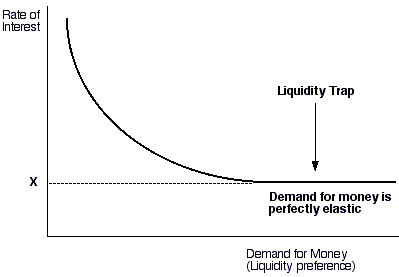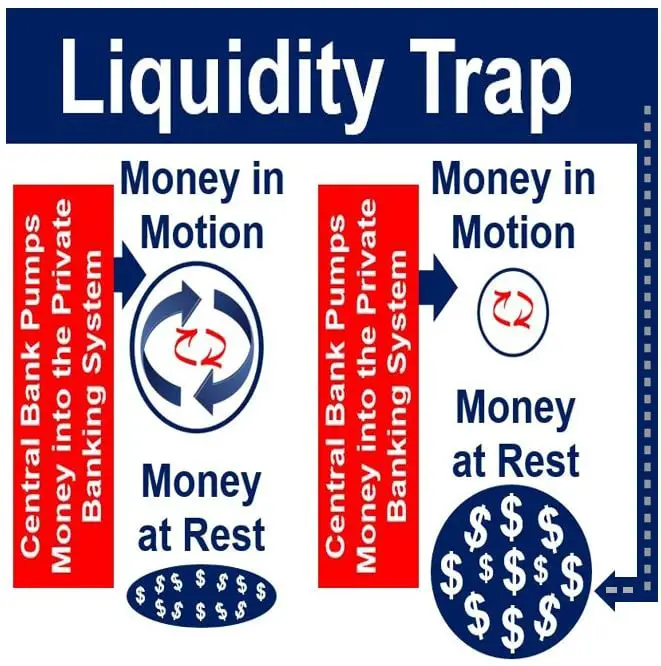A liquidity trap is when expansionary monetary policy (increase in money supply) does not increase the interest rate or income and hence does not stimulate economic growth.

A Simple Explanation with Example.
Picture a scenario called a “liquidity trap.” It’s a peculiar situation in the world of economics where the usual tricks of the trade need to work better. Specifically, when policymakers try to boost the economy by pumping more money into it, a liquidity trap is like the twist ending in a movie – it doesn’t lead to the typical results.
So, here’s the deal: In a liquidity trap, even if you flood the market with extra money (a tactic known as expansionary monetary policy), it doesn’t budge the interest rates or give the economy a much-needed kickstart. It’s like trying to rev up a car engine that’s stuck in neutral. The reason behind this financial standstill is intriguing.
You see, people are in a money-hoarding mood during a liquidity trap. They’d rather clutch onto their cash rather than invest it or lend it out, even when the interest rates are low or, in some cases, at rock bottom (like zero percent). Why, you ask? Well, they’re haunted by the specter of bad things, like the dreaded deflation or the looming threat of war. So, they play it safe and stockpile money, thinking it’s the best insurance policy.
Now, when the interest rates are zilch (zero), folks aren’t too keen on holding bonds either. After all, money and bonds offer a similar zero-interest rate. But money has a clear advantage – it’s handy for everyday transactions. So, if you’re faced with choosing between money and bonds, you’d choose money every time.

This is where the liquidity trap gets really interesting. Even if you pump more money into the system, people won’t suddenly change their minds and start buying up bonds. That means the interest rates on bonds won’t dip below zero – it’s like trying to sell ice cream in the middle of winter; nobody’s buying.
So, in a nutshell, a liquidity trap is a unique situation where standard monetary policy tools don’t work their usual magic because people would rather hang onto their cash than invest it, even when interest rates are exceptionally low. It’s a financial puzzle that requires some creative solutions when it comes to jumpstarting economic growth.
Causes of Liquidity Trap
Deflation: Imagine a scenario where prices keep dropping. In this situation, people tend to stash away their money because they believe their cash will have more buying power. It’s like waiting for a sale to get more bang for your buck.
Recession: During a recession, folks and businesses become cautious. Instead of splurging or investing, they opt to save their money. It’s like tightening your financial belt when unsure about what lies ahead.
Credit Crunch: Businesses find it hard to grow and invest when banks hesitate to lend money. This results in less economic activity, and the demand for money decreases. Think of it as a roadblock on the path to business expansion.
Pessimism: If people lose hope in the economy’s future, they’re more likely to save rather than spend or invest their money. It’s akin to playing it safe when uncertain about the road ahead.
Now, here’s where it gets interesting. When interest rates are already rock-bottom, central banks face a challenge. They can’t simply cut rates further because you can’t go below zero. Their usual monetary tools become somewhat useless when the economy is in a liquidity trap.
Liquidity traps come with their fair share of problems:
Sluggish Economic Growth: When everyone clutches onto their cash, less money is circulating for spending and investment. This can lead to economic slowdowns and more folks needing jobs.
Deflationary Spiral: Picture a cycle where people expect prices to keep dropping, so they avoid spending. This, in turn, causes prices to fall further because demand is low. It’s like a snowball effect but with prices going downhill.
Financial Turmoil: If individuals and businesses can’t secure loans, it can destabilize the financial landscape. This instability can even spark a full-blown financial crisis, which isn’t good news for the economy.
Governments and central banks have a few tricks up their sleeves to combat a liquidity trap. They might employ fiscal stimulus (boosting government spending) or quantitative easing (buying financial assets) to jumpstart economic activity. But here’s the catch: these strategies can be challenging and only sometimes work like a charm.
So, when the economy finds itself in a liquidity trap, it’s like navigating uncharted waters, and policymakers must get creative to steer things back on course.
M.C.Q.
The problem of international liquidity trap is related to the non-availability of ?
A. Gold and silver
B. Goods and Services
C. Dollar and other hard currencies
D. Exportable surplus
